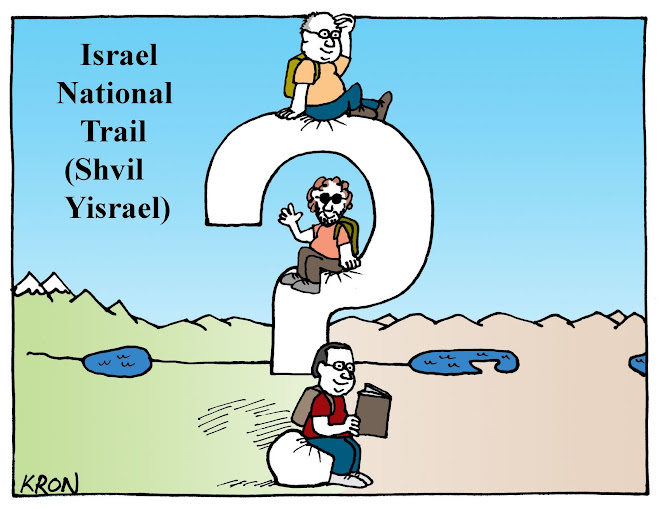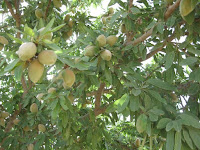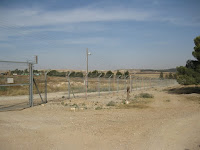
The Israeli spring is
characterized by pleasant warm temperatures with a few days of sharav which
are very dry with intense heat. It turned out that the date we planned to drop
down Har Amasah and cross the desert for the first time, a very strong sharav was
forecast. We had fears that even our plan of starting walking at 5 a.m. so that
we would finish by 10 would leave us dried and fried in the heat.
So we awoke at 4.30, had a cup of coffee, and at 5.00 bid farewell to the Har Amasah Hilton. I'd expected a chill in the air at 5 in the morning at 850 metres above sea level, but the air was what I may describe as "warmish"...not cool and not warm. hmm. An ominous sign of things to come.
So we awoke at 4.30, had a cup of coffee, and at 5.00 bid farewell to the Har Amasah Hilton. I'd expected a chill in the air at 5 in the morning at 850 metres above sea level, but the air was what I may describe as "warmish"...not cool and not warm. hmm. An ominous sign of things to come.
This small kibbutz is not
only in the middle of no-where, but is in the middle of no-where on the border
of the green line, so security is an issue. The gate is permanently closed and
there's meant to be a guard on duty 24\7. Well, at 5 A.M. the sleeping
citizens of the kibbutz were on their own. And so were we. The guard was no-where to be seen. Problem is that
there was a 2 1/2 metre high gate separating us from the white blue and orange
markings that we were so eager to follow. We had some phone numbers of people to ring but their phones were
either disconnected or they didn't answer. After 15 minutes of scratching our
bums it was obvious that there was only one solution. If Clint Eastwood could
do it in "Escape from Alcatraz" we could do it in "Escape from
Har Amasah". So the three 50 year olds somehow scaled the high gate,
landed (fell?) softly on the other side and were happy that no-one was
there to witness what was a very un-graceful manoeuvre.
The downside to our early morning callisthenics was that we got on to
the path at 5.30. Normally half an hour earlier or later is irrelevant,
but half an hour at 10 or 10.30 in the desert might be very relevant. So
be it. Off in the distance beneath us we saw Arad. This is the first
time that we could see our end point from the beginning. The first few
kilometres we walked up and down gentle hills along the ridge that leads
to the peak of Mt. Amasah. It was at once pretty and daunting. The sun
was a red ball that turned orange to yellow as it climbed higher over
the horizon. Beneath us there were Bedouin settlements and a few stands
of trees that dotted the yellow landscape. Very pretty. It was
daunting, however, because we had to cross this landscape in order to
get to Arad.
After stopping for water at the top of Mt Amasah we started the descent down the
side of the mountain into the desert below. Where are your Holy Tablets when you need them? At the foot of the mountain lies
the village of Derijat that is neither Bedouin nor Palestinian Arab but is
inhabited by a local Arab tribe that traditionally lived in caves and worked
the land, Fellachim. We hoped to go through it but the path led us within a
couple of hundred metres of it, but no closer. It looked neat, tidy and
orderly, something that you would never say of any of the Bedouin encampments,
villages or cities in the area. Not long after passing Derijat it was back to the
Bedouins, but not in traditional tents. They were in new caravans. It was a bit
weird to pass by a caravan village in the middle of the desert, but if that's
the way the authorities think they can improve the lot of the Negev Bedouins
then who am I to argue?. I just hope that the Bedouins agreed to leave their
tents and their nomadic lifestyle for the caravan park.
It was after 8 by the
time we reached Tel Arad and it was getting warm. Even though we couldn't allow
ourselves to dawdle I didn't want to pass seeing the well preserved ruins of
a city whose history spans from the bronze age, 4,500 years ago to
the more "modern" 1st temple period of the Israelites. As is so often
the case when the child in me wants to explore , Yoni and Garry roll their
eyes, head for the nearest shade and wait for me to finish looking around. I
found a hole in the fence, poked through and had a quick look. To be
honest, it looked like a big bunch of ruined buildings, which of course is
exactly what it is. I certainly couldn't tell the difference between the
Canaanite and Israelite architecture but given that we had serious time
restraints and Yoni and Garry were waiting for me, my tour was far from in
depth. Under other circumstances, like having an air conditioned car waiting for me at
the end, rather than 2 more hours of walking through rising heat, I would have
quite liked to explore the site more fully and at a leisurely pace.
After leaving Tel Arad
we crossed road no. 80 and the scenery changed. Whilst the geography was the
same, before Tel Arad we'd been walking though arid desert. Now we were walking
past well tended agricultural land that obviously belongs to the Jewish
settlements in the area. It gives discernible meaning to the cliché that
the Zionist movement made the desert bloom. There were almond groves,
wheat and sunflower fields, grape vines, olives and more. Since we'd been walking in
the open the entire time and once we passed these fields we knew that would
continue in the open, this was the perfect spot to rest a bit and have our
sandwiches. Even though we hadn't eaten anything this morning, we were a little
hungry but certainly didn't devour our food with the usual gusto that typifies most of our
shvil legs. For once, eating our sandwiches was an actual physical need rather
than part of the fun.
From here it was past
the Arad sewerage treatment plant that smelt just like the bathroom at our room
at Har Amasah. Yuck. Then on to Arad Park which, with rows of spindly
pine tree, must be one of the least attractive parks that I've seen. It was
getting hotter, though not yet unbearably so. We were walking through barren
open rocky desert and funnily enough, perhaps because it was the first time, we
were really enjoying it. Go figure. The three of us had already finished our
first 2 litre bottle of water each and with water stops every 10 minutes or so,
were well and truly into our second bottle. Despite the heat and obvious
exertion, our shirts were bone dry, the sweat evaporating immediately in the
waterless air. It's actually much more pleasant than being drenched in sweat in
the humid Tel Aviv summer. By the time we reached Arad we will have drunk almost
4 litres each!
The final 3 kilomtres
was through nachal Tze'elim which, though not a deep ravine, was quite pretty
and a welcome respite from the monotonous landscape that we'd been walking
through the previous 10 kilomtres or so. The dry rough creek bed was coloured
purple, red and ochre due to the minerals in the rocks and we could mark it
down as another first in our more than two years on the shvil.
By
10.30 we
had reached Arad and the heat was starting to have a kick to it. We
could have plodded another 3 km through town to the car, but it was
never a realistic option. Instead, we called a cab and waited on a
bench outside the local supermarket, pondering whether the cab-driver
would let us 3 derelicts into his car. A brand new shiny Volvo pulled up
and judging by the snarl on the driver's face, he wasn't happy having
half of the sand of the Negev and 3 smelly Australians filthy up his
taxi. He ensured that we had only the minimum possible stay in his cab
by covering the distance to Garry's parked car in a time and manner
that, had they seen the performance, would have had the Ferrari FI
racing team offering him a long term contract. Oh well.
Planning the logistics
properly allowed us to finish the 20 km without suffering. We also know that as
we get further into the desert after Arad, logistics is going to be even more the make or
break for us. We'll deal with that as we get closer to the time. For the moment
we were more concerned with quenching our thirst at 11 a.m. with a well
deserved beer back at the Muza pub.






















































